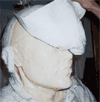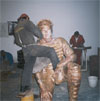
|
Recently, Master Ariza has dedicated him self to produce Life size and monumental sculptures. Based on the need of the human being to depict himself, the “Egorealism” takes place. The history of art, shows us, that the artists have been always used to identify their work according to the artistic tendencies left to us, by those who without proposing it, left a style, or a school, which was discovered by the analysts, students and writers of art, who baptized them at their time, with a name that described the style. The " Egorealism” is born, with a name that the Master Amilkar Ariza has given to his new artistic tendency, and that is the result of a conscious work that he has developed during many years.
The Egorealism of Amilkar Ariza, is the art of the moment, the art of the time, of the communication, that transmits energies to the observer. It is the kind of work that does not require to be an art expert to feel it. The egorealistic sculpture of Ariza, besides to contribute to art, shows a strong empathy to it and causes the bronze and the person to integrate in a passion manner. Definitively, the "Egorealism" of Amilkar Ariza, is a new artistic tendency in the sculpture, that adds new ingredients to the art, penetrates the feelings, and gives a more dynamic turn to the generally volumetric and statue-kind sculpture, perhaps by the rigidity of the handling of the bronze; in the work of Ariza, the heavy thing of the material becomes light, participates with the today life, and elevates the ego of those who observes it. |
|||||||||||||





